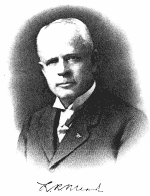

 1863 Salt Mines [page 2]
1863 Salt Mines [page 2]The Risdon and Mead Family
The "Saline Salt Manufacturing and Mining Company" was incorporated in 1863 to exploit the salt springs and stock certificates issued. Manufacture of salt evaporation pans would be made at the Risdon Iron Works. The endeavor ended before it actually began. Manufacturing and transporting salt from the Hot Springs was not economically feasible given the difficulty of shipping the product. Other salt manufacturing operations in Napa, Sonoma, and the San Francisco Bay were supported by established transportation and distribution systems. No railroad serviced the area at the time and overland/teamster hauling was prohibitively expensive. The salt manufacturing idea was dropped and the property continued as an informal spa and watering hole as before. People camped at the site, bathed in the pools, and drank the waters for their various healthful and cathartic effects.
The Civil War ended and the land patent was finally signed and granted by President Andrew Johnson in October 1865. Risdons’ nephew, Lewis Risdon Mead, 18, arrived the same year. Lewis was the son of their sister, Blanche Risdon Mead and the only daughter of the seven children born to Orange Risdon, Sr. Lewis Risdon Mead became associated with the family Iron Works and found a business niche for himself in developing the 160 acre Salt Springs property along with his uncle Orange. The Springs were increasing popular with campers "squatting" on the property. Loosing property to "squatters" was a real threat to real estate ownership at the time. Perhaps to defend title or sensing a business opportunity, Orange Risdon and Lewis Mead set to work. The initial buildings were improved; springs dug, lined, and covered; "bath houses" (changing rooms) added; and overnight accommodations provided for those visiting the Springs. The beginnings of the "world famous" health resort were in place.
The Springs were named according to their content or the purpose for which they were used. The Salt Springs are heavily laden with salt; the liver and kidney springs were drunk by many of the guests under the impression that these two organs greatly benefited or were cleansed by its use; the sulfur springs contained a high percentage of sulfur and were housed in a separate building. Each guest received a sheet of instructions from the doctor concerning the proper use of the waters from each spring for a particular ailment. The swimming pool, forty-four feet long, twenty feet wide and four to six feet in depth was housed in a separate building and known as the ''Gas Plunge" because a natural gas constantly bubbled through the water.
Events took a dramatic change in 1873 when Orange Risdon, Jr. died unexpectedly on a trip in San Luis Obispo County. Orange had never married and died without heirs. His estate consisting of cash and the Salt Springs real estate reverted to his father, Orange Risdon, Sr. residing in Michigan. The court appointed Lewis R. Mead as administrator of the estate. Mead, leased the hot springs property to Amanda E. Gallagher who is credited with building bath houses over several of the springs and establishing a stage line from the town of Byron. Mead proceeded to purchase the 160 acre Salt Springs from his grandfather, Orange, settled the estate, and applied to Superior Court to probate and confirm the sale all in one legal proceeding. Mead believed clear title was now his.
[next] [back to the top] [1] [3]
Home l Resort Plans l History l Golf Course l Resort Store l Newsroom l Contact Us
© 2004 Byron Hot Springs